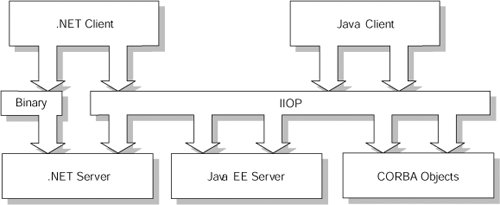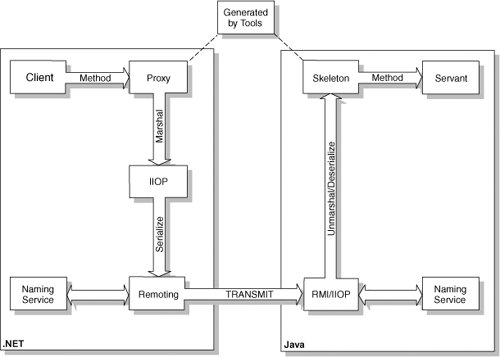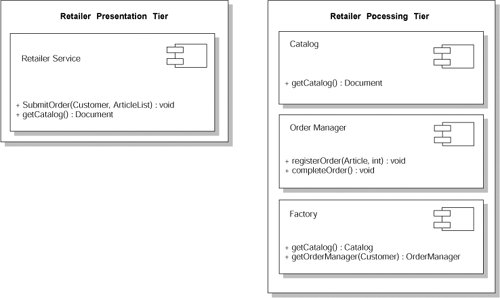IIOP.NET for Java EE .NET Integration
| IIOP.NET is a technology that allows .NET, Java EE, and CORBA components to interoperate seamlessly using the CORBA-based Internet Inter-Orb Protocol (IIOP). This solution relies on the extensibility of the .NET Remoting architecture to offer transparent, object-level integration without incurring the performance overhead that gateways or SOAP-based products impose. This technology is available to the software community under the LGPL license as an open-source project at http://iiop-net.sourceforge.net. ScopeIIOP.NET is an interoperability solution for enterprise applications. It allows interoperation with other peers that understand the IIOP protocol, such as Java EE and CORBA-based objects. It fully supports bi-directional interoperability, including callbacks, and using distributed objects allows a quasi-natural object-oriented programming style by making references to remote objects almost transparent. These remote objects can be both stateless or stateful. The framework is also transparent to the applications that use it due to the fact that it is installed into the .NET Remoting infrastructure (which roughly corresponds to Java RMI)objects can communicate with other remote objects without any knowledge of the underlying technology on which they are implemented. Interoperation via IIOP is not a replacement for SOAP or Web services; the two approaches complement each other in a very natural way. SOAP is best suited for the integration of loosely-coupled services, which are typically stateless and relatively coarse-grained. CORBA objects and Enterprise Java Beans (EJBs) are usually finer-grained and more tightly-coupled than Web services; IIOP, which allows efficient, object-level interactions, is the optimal technology for such cases. SolutionIIOP.NET takes advantage of the configurability aspects of the .NET Remoting infrastructure (refer to Figure 5-1). At its core is an IIOP Remoting channel that is plugged into the .NET Framework, exactly like the built-in binary and SOAP channels. Consisting of transport sink, formatter, and type-mapper, the remoting channel marshals method invocations and parameters between CORBA and .NET. Figure 5-1. IIOP.NET opens the IIOP world to .NET. Besides these runtime components, the solution also includes the build tools that Java and .NET developers need to work with the CORBA interface definitions language (IDL) and the .NET common language specification (CLS):
IIOP.NET ChannelThe IIOP.NET channel is a plug-in for the .NET Remoting infrastructure. It implements a formatter for marshaling the method invocations and a transport sink for handling the low-level networking details (in this case TCP/IP connections). Refer to Figure 5-2. Figure 5-2. Overview of the .NET Remoting infrastructure The major difference from the other built-in remoting components is that IIOP.NET allows interoperability with peers other than .NET. To be part of a distributed object system, the .NET objects face one of two choices:
More details about .NET Remoting are beyond the scope of this text and can be found in the .NET Framework documentation. IIOP.NET ToolsIIOP.NET includes compilers to generate .NET proxies from CORBA IDL definitions and to generate IDL definitions from compiled .NET Assemblies. The IDLToCLSCompiler takes one or more IDL definitions and generates a DLL containing the proxies for the defined types. Refer to Figure 5-3. Figure 5-3. IDL to CLS compiler In Figure 5-4, the CLSToIDLGenerator creates the IDL definitions contained in one or more .NET assemblies. Both tools operate directly on the .NET assemblies to be completely language agnostic. Figure 5-4. CLS to IDL compiler Using IIOP.NETUsing IIOP.NET to implement client objects is relatively simple and can be done using four steps. Refer to Figure 5-5.
Figure 5-5. A distributed object system with IIOP.NET Using .NET server objects from Java is as simple as:
BenefitsIIOP.NET opens the CORBA world to .NET; CORBA defines a protocol that is used to support distributed object systems. This protocol is flexible enough to provide additional services, such as security and transactions, and has many widespread implementations. Most of the architectural benefits are provided by the IIOP protocol.
Other benefits are
LimitationsArchitectural limitations are imposed by the model chosen and cannot be removed:
ExamplesThe Supply Chain Management reference application from the WS-I is used throughout this book for examples on interoperability. Here's a short example based on the Retailer part of the application. In Figure 5-6, Web services communicate between applications (like the client and the Retailer system), and a distributed object system implements the communication between the presentation and the Processing tier of the Retailer system. Figure 5-6. Logical architecture of Supply Chain Management application The Retailer application consists in a Presentation tier, which provides the rest of the world with Web service access to the Retailer system and is implemented with .NET; the Processing tier consists of some Java-remotable components published through RMI/IIOP. Here stateful components are used and not EJBs because the same interface is already used for the Web access to the application. The Presentation tier communicates with the Processing tier using IIOP.NET. The Processing tier defines three interfaces. Refer to Listing 5-1. Listing 5-1. Catalog Interface
The Factory is a singleton object that creates instances of the other objects for remote use. Refer to Listing 5-2. Listing 5-2. Three Interfaces Defined in the Processing Tier
The first step toward interoperability is to create the IDL description of the Catalog, OrderManager, and Factory interfaces: rmic classpath . iiop Catalog rmic classpath . iiop OrderManager rmic classpath . iiop Factory Using these IDL files, the IDLToCLSCompiler generates the proxy classes for .NET: IDLToCLSCompiler ProxyClasses Catalog.idl OrderManager.idl Factory.idl This command generates ProxyClasses.dll, an assembly that contains the definitions for the types defined in the IDL files. Obviously it's important to have all files in the right directory, but all these commands also have options to use different directories for their work. Now the .NET Web service is implemented, which must register the IIOP.NET channel, connect to the server, and access the remote objects. The first thing to do is to configure the Web service by registering the channel and fetching a reference to the factory. Refer to Listing 5-3. Second, the Web service implementation uses the objects in the Production tier. Note how the list of orders is processed by submitting each order singularly to the existing stateful interface. Refer to Listing 5-4. Listing 5-3. Configuring .NET Web Service
Listing 5-4. RetailerService
ResourcesThe IIOP.NET project is hosted on sourceforge (http://iiop-net.sourceforge.net/) and maintained by Dominic Ullmann and Patrik Reali and sponsored by ELCA Informatique SA. The project includes many tutorials and code examples on how to interoperate with peers other than .NET, including the details for the various application servers and ORBs. The documentation page (http://iiop-net.sourceforge.net/documentation.html) contains the overview of all documentation available. This page also links external tutorials and articles about IIOP.NET. |
EAN: 2147483647
Pages: 170
